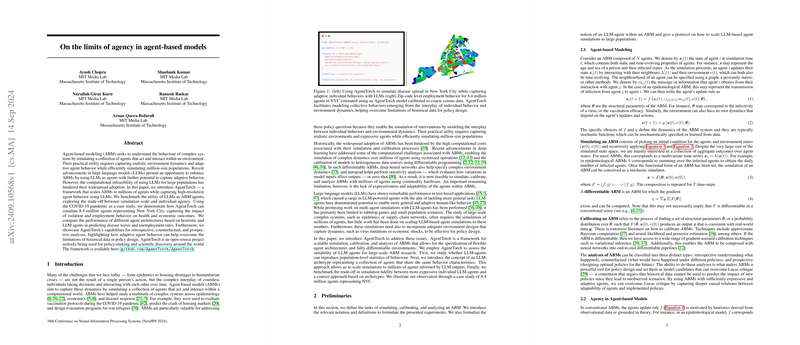Assessing the Role of Agency in Scaling Agent-Based Models with LLMs
Agent-based modeling (ABM) is an essential tool for understanding complex systems, especially those influenced by individual actions and interactions within a defined environment. However, traditional ABMs face limitations in expressiveness and adaptability of agents and are computationally intensive when simulating large populations. The paper "On the Limits of Agency in Agent-Based Models" by Chopra et al. introduces AgentTorch, a novel framework designed to integrate LLMs as agents within ABMs, thereby enhancing the behavioral adaptability of simulated agents and achieving scalability.
Contributions and Methods
The primary contributions of the paper can be summarized as follows:
- AgentTorch Framework: The development of AgentTorch, a framework designed to facilitate the integration of LLMs in simulating agent behavior within ABMs and scaling the simulation to millions of agents.
- LLM Integration: The proposal of LLM-archetypes, a method to scale behavior simulation by categorizing similar agents and using representative LLMs which reduces computational overhead.
- Benchmark and Case Study: A benchmark using the COVID-19 pandemic serves to illustrate the practical applications of AgentTorch.
- Practical Analysis: The use of AgentTorch for various types of ABM analyses such as retrospective, counterfactual, and prospective policy evaluations.
Detailed Examination
The integration of LLMs as agents in ABMs offers the potential for more nuanced and adaptive representations of individual actions and interactions. In the context of AgentTorch, the computational feasibility of using LLMs is addressed through the concept of LLM archetypes. By categorizing agents into archetypes based on shared characteristics, it becomes possible to significantly reduce the number of LLM queries necessary for large-scale simulations.
Simulation Environment
Within the AgentTorch framework, the simulation encompasses both disease dynamics and labor market behaviors, parameterized using standard models. Agents update their states based on their interactions and the environment. For instance, in modeling the spread of COVID-19, individual agent behavior is influenced by factors such as isolation and employment decisions, which are determined using LLM-generated probabilities for respective archetypes.
Benchmark Results
The paper's benchmarks demonstrate that LLM archetypes can effectively simulate population behaviors, yielding strong correlations with real-world data. For instance, behavior prediction models for labor force participation during the pandemic showed that including contextual information in LLM prompts improved correlation with observed data across various boroughs of New York City. This was particularly notable in the transition period when stimulus payments were issued or exhausted, offering an insightful understanding of adaptive behaviors over time.
Additionally, the calibration of ABM parameters using differentiable programming was shown to be effective when integrating LLM agents. Comparisons between heuristic agents, LLM-agents, and LLM archetypes indicated that while LLM-agents provide high fidelity for individual behaviors, LLM archetypes strike a balance between individual expressiveness and computational scalability. Notably, LLM archetypes were able to accurately predict trends and help simulate large populations, without the prohibitive computational costs associated with using unique LLMs for every agent.
Analysis and Implications
AgentTorch facilitates comprehensive ABM analyses:
- Retrospective Analysis: It allows for detailed exploration of the impact of historical interventions by correlating simulated behaviors and outcomes with real-world data. An example from the paper demonstrates how the impact of stimulus payments on employment was evaluated at granular geographic resolutions.
- Counterfactual Analysis: This capability was showcased by simulating alternative pandemic scenarios, such as delayed onset of the Delta variant and early emergence of Omicron variant, providing insights into the relative impact of behavioral adaptation versus viral transmissibility.
- Prospective Analysis: The framework is also useful in designing future policies by testing out hypothetical scenarios and interventions. For example, the paper demonstrated the strategic implications of modifying vaccine dosage schedules under variable supply-chain constraints and public health requirements.
The implications of AgentTorch are noteworthy for both theoretical advancements and practical applications. Theoretically, it expands the utility of ABMs by combining differentiation and composability with neural network models, including LLMs. Practically, the framework enables policymakers and researchers to create more reliable simulations that account for adaptive behaviors, thus providing better-informed decisions.
Future Developments
The adaptation of LLMs within agent architectures opens numerous avenues for future research. Some promising directions include:
- Enhancing the robustness and fairness of LLM-driven agents to mitigate biases and ensure equitable outcomes.
- Exploring more expressive action frameworks for LLM-based agents to simulate more complex real-world scenarios.
- Integrating multi-modal data sources to further enrich contextual inputs for LLMs, allowing them to make more informed behavioral predictions.
Conclusion
The paper "On the Limits of Agency in Agent-Based Models" presents a significant step forward in ABM research, leveraging the potential of LLMs to address the expressiveness and scalability challenges traditionally associated with ABMs. AgentTorch demonstrates a balanced approach to capturing complex agent behaviors while maintaining computational feasibility for large-scale simulations. This framework offers robust tools for retrospective, counterfactual, and prospective analyses, paving the way for innovative policy design and scientific discovery.
